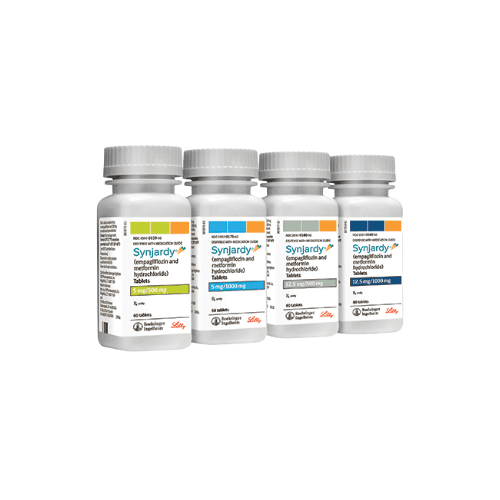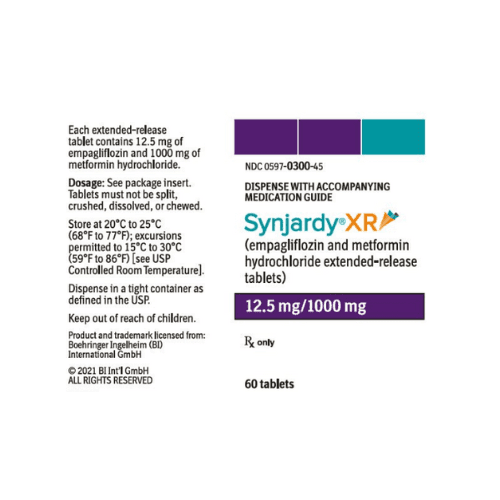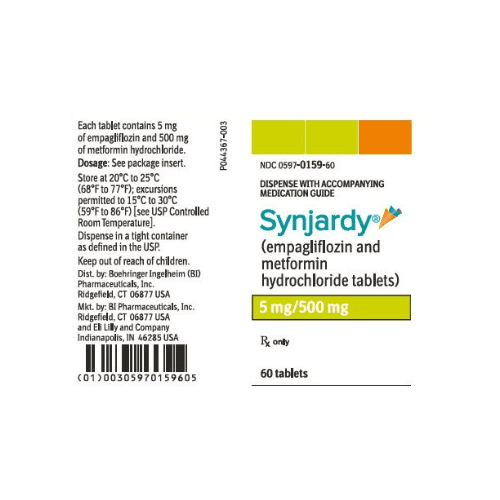Shipping with this method takes 3-5 days
Synjardy® Tablets for Type 2 Diabetes
Price range: $130.99 through $135.99
Secure Encrypted Payments
Synjardy® is a prescription tablet that combines empagliflozin and metformin to help manage type 2 diabetes in adults. This page explains how it works, common safety points, and how to order with US shipping from Canada, including options if you pay without insurance.
What Synjardy Is and How It Works
This medicine pairs two proven diabetes agents. Empagliflozin is an SGLT2 inhibitor that helps your kidneys remove extra glucose in the urine. Metformin decreases liver sugar production and improves insulin sensitivity. Together, the treatment supports better blood glucose control when added to diet and exercise. Learn more about metformin’s role in care in our overview Metformin And Its Role.
YouDrugstore is a licensed Canadian pharmacy in Manitoba. Pharmacists review prescriptions before dispensing.
There is no synjardy generic currently approved. Your prescriber chooses the dose based on your needs and kidney function. Always follow the directions on your prescription label.
Who It’s For
This combination is indicated for adults with type 2 diabetes who need additional glycemic control alongside diet and exercise. It is not for type 1 diabetes or for treating diabetic ketoacidosis. People with significant kidney disease, dehydration, or heavy alcohol use may not be candidates. Your clinician may also review heart history, risk of urinary and genital infections, and past episodes of lactic acidosis when deciding if this therapy is appropriate. For background on the condition, see our category for Type 2 Diabetes.
Dosage and Usage
Tablets are usually taken with meals to reduce stomach upset. Immediate-release tablets are commonly taken twice daily with the morning and evening meal. Extended-release versions are typically taken once daily with food, often in the evening. Swallow tablets whole. Do not crush or chew extended-release tablets. If your clinician adjusts other agents such as insulin or a sulfonylurea, it is to reduce low blood sugar risk.
Hydration matters with this class. Drink enough fluids unless your prescriber has advised a restriction. Stand up slowly to limit dizziness, especially if you take diuretics. If you develop vomiting, diarrhea, or cannot keep fluids down, contact a healthcare professional for advice and review the official label.
For general supplies and meters, explore Diabetes Care to support your overall regimen.
Strengths and Forms
The combination is supplied as oral tablets in immediate-release and extended-release presentations. Multiple fixed-dose strengths exist to pair empagliflozin with metformin across a range of amounts. Availability can vary by manufacturer pack and country. Your prescriber will select a strength that aligns with your current metformin dose and kidney function.
Missed Dose and Timing
If you miss a dose, take it when you remember with food, unless it is close to the next scheduled dose. If it is near the next dose, skip the missed dose and resume your regular schedule. Do not double up to make up for a missed tablet. For extended-release tablets, the same general approach applies. If you are unsure, consult your prescriber or pharmacist.
Storage and Travel Basics
Store tablets at room temperature in the original container with the lid closed, away from moisture. Keep out of reach of children and pets. Do not store in the bathroom. When traveling, carry the medicine in your hand luggage, along with your prescription label and a copy of your prescription if available. Maintain your usual dosing times when changing time zones by planning with your prescriber in advance. If you use a weekly pill organizer, ensure child safety at home and keep the original bottle for reference.
Benefits
This therapy can lower blood sugar and support A1C reduction when used with diet and exercise. The once-daily extended-release option may simplify routines for some people. As an SGLT2 plus metformin combination, it can reduce the need to take separate tablets from two different drug classes. Your overall results depend on dose, adherence, diet, activity, and other medicines.
Side Effects and Safety
- Common GI effects: nausea, diarrhea, stomach discomfort, or gas
- Urinary effects: increased urination or urinary tract infections
- Genital yeast infections may occur in both men and women
- Dizziness, especially when standing up quickly
- Headache or fatigue
Serious but less common risks include ketoacidosis, dehydration, kidney problems, and lactic acidosis related to metformin. Very rare soft tissue infections in the genital area have been reported with SGLT2 inhibitors. Hypoglycemia can occur when used with insulin or a sulfonylurea. Seek urgent care for symptoms such as severe abdominal pain, trouble breathing, sweet breath, confusion, fainting, or signs of allergic reaction. Review the full Prescribing Information for complete safety details.
Drug Interactions and Cautions
Tell your clinician about all medicines and supplements. Diuretics can increase dehydration and dizziness risk. Iodinated contrast imaging may require temporary interruption of metformin. Excess alcohol increases the chance of lactic acidosis. Insulin and sulfonylureas may increase low blood sugar risk when used together with this treatment. Strong changes in kidney function can affect how the therapy is used. Always defer to the official label and your prescriber’s guidance.
What to Expect Over Time
Glucose readings may improve as you take the tablets consistently with meals. A1C changes typically reflect several weeks to months of steady use. Diet, activity, and adherence are key. Consider keeping a log of readings, meals, and doses to share at checkups. For lifestyle ideas, see our article Reverse Prediabetes Naturally and awareness piece National Diabetes Month 2025.
Compare With Alternatives
Other SGLT2 plus metformin options include Invokamet. A DPP-4 inhibitor such as Tradjenta may be used with metformin in some patients. Overall empagliflozin metformin cost varies by brand, strength, and quantity, so discuss options with your prescriber if you are considering a switch based on tolerability, suitability, or budget.
Pricing and Access
We list transparent options so you can compare synjardy price by strength and quantity. You can also review empagliflozin metformin price when evaluating alternatives or extended-release options. Canadian pricing can help lower cash-pay spending compared with typical US retail. We provide card checkout with encrypted processing for your security.
Looking for savings? See current offers on our Promotions page. We provide US delivery from Canada to most states; the parcel Ships from Canada to US after your prescription is verified. Taxes and dispensing fees vary by order details.
Availability and Substitutions
Inventory can vary by strength and manufacturer pack. If your preferred option is unavailable, your prescriber may recommend an alternative with the same active ingredients or a different class. Our team can coordinate with your clinician if a substitution is requested by your pharmacy. This prescription ships to the US according to importation rules for personal use with a valid prescription.
Patient Suitability and Cost-Saving Tips
This therapy may suit adults with type 2 diabetes who need additional control and tolerate metformin. It may not be suitable if you have severe kidney disease, frequent urinary infections, or a history of lactic acidosis. To manage synjardy out of pocket cost, consider larger fills when appropriate, which can reduce per-bottle fees. Align refills with clinic visits to avoid gaps, and set phone reminders for renewal dates.
If you travel often, keep a small reserve supply and a paper copy of your prescription. Discuss sick-day rules with your clinician, including when to pause the medicine for dehydration, severe illness, or contrast procedures.
Questions to Ask Your Clinician
- Is this combination appropriate with my kidney function and other conditions?
- Should I reduce insulin or sulfonylurea to lower low blood sugar risk?
- Which tablet schedule is better for me, immediate-release or extended-release?
- What lab monitoring do I need over the next year?
- What signs mean I should stop the medicine and contact you?
Authoritative Sources
FDA DailyMed: Synjardy Prescribing Information
Boehringer Ingelheim: Synjardy Product Page
Health Canada Drug Product Database: Synjardy
Ready to proceed? You can buy synjardy online at YouDrugstore for US delivery from Canada with prompt, express shipping and temperature-controlled handling when required. This information is for general education and is not a substitute for advice from your healthcare professional.
Express Shipping - from $25.00
Prices:
- Dry-Packed Products $25.00
- Cold-Packed Products $35.00
Shipping Countries:
- United States (all contiguous states**)
- Worldwide (excludes some countries***)
Standard Shipping - $15.00
Shipping with this method takes 5-10 days
Prices:
- Dry-Packed Products $15.00
- Not available for Cold-Packed products
Shipping Countries:
- United States (all contiguous states**)
- Worldwide (excludes some countries***)
How does this combination help manage blood sugar?
The tablet pairs empagliflozin, an SGLT2 inhibitor, with metformin. One helps remove extra glucose through the urine, while the other reduces liver sugar production and improves insulin sensitivity. Used with diet and exercise, the two mechanisms complement each other to help lower fasting and post‑meal glucose. Your clinician will decide the dose and schedule, and will adjust other agents if needed to minimize low blood sugar risk.
Can I take it if I have kidney problems?
Your prescriber will check kidney function before starting and during treatment. Some people should not start or should stop the medicine if kidney function is too low. Dehydration, illness, or certain imaging tests may temporarily change how it is used. Follow your clinician’s guidance and the official label. Seek advice promptly if you notice reduced urine, swelling, or sudden weight gain.
What side effects should I watch for?
Common effects include nausea, diarrhea, stomach upset, increased urination, and genital yeast infections. Dizziness can occur, especially when standing quickly. Rare but serious risks include ketoacidosis, severe dehydration, kidney issues, lactic acidosis, or a serious genital infection. Get urgent help for severe abdominal pain, trouble breathing, or signs of allergic reaction. Report persistent or bothersome symptoms to your healthcare professional.
How should I take the tablets?
Take tablets with food. Immediate‑release is often taken twice daily with meals, while extended‑release is commonly once daily with an evening meal. Swallow tablets whole. Do not crush or chew extended‑release tablets. If you miss a dose, take it when remembered unless it is close to the next dose, then skip the missed dose. Never double up. Follow your prescription label and ask your pharmacist if unsure.
Is there a lower‑cost option or a generic available?
At this time, no approved generic version of the combination is widely available. Your clinician may consider other SGLT2 plus metformin products or a different class if cost or tolerability is a concern. Some patients also adjust quantity sizes to improve per‑fill expenses. Check our site for Canadian pricing and current promotions, and discuss alternatives with your prescriber.
Will it cause low blood sugar?
On its own, the combination is not usually associated with low blood sugar. However, hypoglycemia may occur when it is used with insulin or sulfonylureas. Your clinician may adjust those agents to lower that risk. Know the symptoms of low blood sugar, carry a quick source of glucose, and monitor more frequently when starting or changing doses.
What lifestyle steps support this treatment?
Consistent meals, portion control, and regular activity can improve results. Stay hydrated unless told otherwise. Track home glucose readings and bring them to checkups. Set reminders so you take doses with food at the same times each day. Work with your prescriber on weight, blood pressure, and lipid goals for overall cardiometabolic health.



